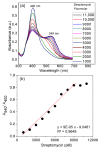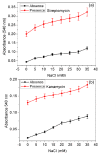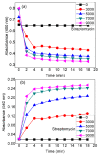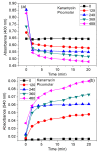Chlortetracycline-Functionalized Silver Nanoparticles as a Colorimetric Probe for Aminoglycosides: Ultrasensitive Determination of Kanamycin and Streptomycin
- PMID: 32455981
- PMCID: PMC7279544
- DOI: 10.3390/nano10050997
Chlortetracycline-Functionalized Silver Nanoparticles as a Colorimetric Probe for Aminoglycosides: Ultrasensitive Determination of Kanamycin and Streptomycin
Abstract
Aminoglycosides (AMGs) have been extensively used to treat infectious diseases caused by Gram-negative bacteria in livestock and humans. A selective and sensitive colorimetric probe for the determination of streptomycin and kanamycin was proposed based on chlortetracycline-coated silver nanoparticles (AgNPs-CTC) as the sensing element. Almost all of the tested aminoglycoside antibiotics can rapidly induce the aggregation of AgNPs, along with a color change from yellow to orange/red. The selective detection of aminoglycoside antibiotics, including tobramycin, streptomycin, amikacin, gentamicin, neomycin, and kanamycin, with other types of antibiotics, can be achieved by ultraviolet (UV) spectroscopy. This developed colorimetric assay has ability to detect various AMGs using in-depth surface plasmon resonance (SPR) studies. With this determination of streptomycin and kanamycin was achieved at the picomolar level (pM) by using a UV-visible spectrophotometer. Under aqueous conditions, the linear range of the colorimetric sensor for streptomycin and kanamycin was 1000-1,1000 and 120-480 pM, respectively. The corresponding limit of detection was 2000 pM and 120 pM, respectively. Thus, the validated dual colorimetric and ratiometric method can find various analytical applications for the ultrasensitive and rapid detection of AMG antibiotics in water samples.
Keywords: aminoglycoside antibiotics; chlorotetracycline antibiotics; picomolar level sensitivity; silver nanoparticles; ultrasensitive detection; water samples.
Conflict of interest statement
There is no conflict of interest to declare.
Figures







References
-
- Liu Q., Li J., Song X., Zhang M., Li E., Gao F., He L. Simultaneous determination of aminoglycoside antibiotics in feeds using high performance liquid chromatography with evaporative light scattering detection. RSC Adv. 2017;7:1251–1259. doi: 10.1039/C6RA26581B. - DOI
-
- Gaudin V., Hedou C., Rault A., Verdon E. Validation of a Five Plate Test, the STAR protocol, for the screening of antibiotic residues in muscle from different animal species according to European Decision 2002/657/EC. Food Addit. Contam. Part A. 2010;27:935–952. doi: 10.1080/19440041003677483. - DOI - PubMed
-
- Van Holthoon F.L., Essers M.L., Mulder P.J., Stead S.L., Caldow M., Ashwin H.M., Sharman M. A generic method for the quantitative analysis of aminoglycosides (and spectinomycin) in animal tissue using methylated internal standards and liquid chromatography tandem mass spectrometry. Anal. Chim. Acta. 2009;637:135–143. doi: 10.1016/j.aca.2008.09.026. - DOI - PubMed
Grants and funding
LinkOut - more resources
Full Text Sources

